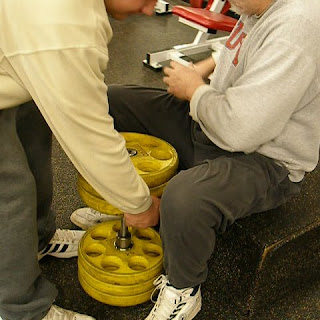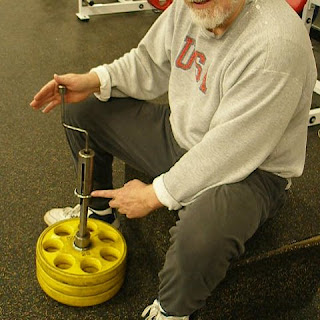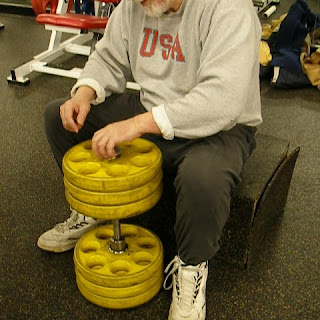One of the things I rail about in my book, Diagnostic Bodybuilding, is the use of “tracked machines,” as they restrict your plane of movement and cause the unused muscle fibers to atrophy.
Then it hit me. Why not increase the plane of movement, engage more muscle fibers, and thereby enhance growth? My reasoning went like this: let’s start with an adjustable incline bench. No bench currently on the market can be adjusted in less than 12-degree increments.
Twelve degrees may not seem like much. Try this simple experiment. Do a set of dumbbell bench presses with the bench completely flat. Use a weight you can do comfortably for 4-6 reps. Now raise the bench 12 degrees, to the first notch. Can’t budge the same weight, can you? Weak as a kitten, aren’t you? Why is this?
It’s the same principle that I used to develop the Sticking Point Smashers. You increase weight in small increments, you increase the angle you lift the weight in small increments. At 12-degree increases in angle, you are engaging muscle tissue that, to some extent, has been “dormant.”
The bench I am in the process of developing doesn’t increase in 12-degree increments; it increases in 3-degree increments.
For example, let’s say you’re doing flat bench dumbbell presses with 120 pounds in each hand. Let’s say you work up to a decent number of reps, say 6-8. You increase the incline or angle of the bench by a mere 3 degrees. Your reps will drop, but you will still be able to lift the weight. When you are back up to 6-8 reps, increase the incline by another 3 degrees.
If my theory is correct, you will eventually be sitting straight up with 120 pounds in each hand, doing 6-8 reps in the dumbbell press.
There is, of course, another way to use such a bench. Vary the angle in each set, in each workout. For example, let’s say you do 5 to 10 sets in a workout, increasing the angle 3 degrees for each set. Then, the next workout, increase another 3 degrees for each set. If you do 10 sets a workout in 3 workouts, you will have exercised the arm, shoulder, and chest muscles from thirty different angles.
What would this do for you? According to Dr. Tom Trimble, chiropractor, when I explained my theory to him, his opinion was that the result would be extremely accelerated muscle growth in that area. More angles equal more muscle fibers reached.
By building the underlying pectoral muscles to a large degree, this may also turn out to be something of a bust developer.
Tuesday, November 11, 2008
Thursday, April 24, 2008
Fasting: not always a good thing
Fasting is normally a good thing. It’s mentioned in the Bible, in numerous books, and in magazine articles. Fasting detoxifies the body. The 10-day brown rice fast I described in Diagnostic Bodybuilding was a good thing.
I recently went on a fast involving nothing but canned tomatoes and fresh grapefruit, alternating each item for six small meals a day. The two ladies who talked me into going on this fast—it lasts 7 days—told me it increased their energy significantly on Day 6 and Day 7 of the fast. Theoretically, you get sick and run a fever on Day 2 as the body detoxifies.
Why so heavy a concentration of acidic food? Supposedly, the body reacts to the acid by overcompensating alkaline.
My experience with this fast was as follows:
1. I got sick on Day 1.
2. By Day 5 I couldn’t look at another tomato.
3. By Day 6 I couldn’t handle another grapefruit.
4. I had no energy increase.
5. Worse, for several days after I finished this fast, I was extremely short-winded.
6. After the fast I had more color in my cheeks. Did my circulation improve? I don’t know.
Try it. You probably won’t like it.
I recently went on a fast involving nothing but canned tomatoes and fresh grapefruit, alternating each item for six small meals a day. The two ladies who talked me into going on this fast—it lasts 7 days—told me it increased their energy significantly on Day 6 and Day 7 of the fast. Theoretically, you get sick and run a fever on Day 2 as the body detoxifies.
Why so heavy a concentration of acidic food? Supposedly, the body reacts to the acid by overcompensating alkaline.
My experience with this fast was as follows:
1. I got sick on Day 1.
2. By Day 5 I couldn’t look at another tomato.
3. By Day 6 I couldn’t handle another grapefruit.
4. I had no energy increase.
5. Worse, for several days after I finished this fast, I was extremely short-winded.
6. After the fast I had more color in my cheeks. Did my circulation improve? I don’t know.
Try it. You probably won’t like it.
Tuesday, March 18, 2008
Pictures of the Mother of All Dumbbells
 ~~~~~~~~~~~~~~~~~~~~~~~~~~~~~~~~~~~~~~~~~
~~~~~~~~~~~~~~~~~~~~~~~~~~~~~~~~~~~~~~~~~Putting the end cap on to hold plates on (outside collar)
Inside adjustable collar is ring that slides up and down slot
Tool used to adjust inside collar
 ~~~~~~~~~~~~~~~~~~~~~~~~~~~~~~~~~~~~~~~~~
~~~~~~~~~~~~~~~~~~~~~~~~~~~~~~~~~~~~~~~~~Pointing to adjustable inside collar
View of both outside (top) and inside (lower) collars
 ~~~~~~~~~~~~~~~~~~~~~~~~~~~~~~~~~~~~~~~~~
~~~~~~~~~~~~~~~~~~~~~~~~~~~~~~~~~~~~~~~~~Placing 25-lb plates on MOAD
 ~~~~~~~~~~~~~~~~~~~~~~~~~~~~~~~~~~~~~~~~~
~~~~~~~~~~~~~~~~~~~~~~~~~~~~~~~~~~~~~~~~~Screwing on outside collar
One dumbbell deadlift-162.5 lbs
 ~~~~~~~~~~~~~~~~~~~~~~~~~~~~~~~~~~~~~~~~~
~~~~~~~~~~~~~~~~~~~~~~~~~~~~~~~~~~~~~~~~~Trying to lift and balance 162.5 lb MOAD
Much harder to balance with an Olympic bar,
consequently much less productive
to the development of grip strength

Saturday, March 8, 2008
How the Mother of All Dumbbells came to be
This is no ordinary dumbbell. It has screw on end caps. There is a hole through the center of the dumbbell that allows the user to adjust the inside collars by means of screw threads so the barbell plates don't rattle around.
The dumbbell can be further modified by removing the handle and screwing in successively thicker handles.
You might wonder, why so much detail in a dumbbell? Two reasons.
First, the commercial gym I go to has a dumbbell rack that increases in 5-lb increments to only 125 lbs. For those of you who have seen the cover of Diagnostic Bodybuilding, you will easily recognize that "I'm about out of weight." I can carry less than 26 lbs of equipment (MOAD) into the gym and easily load my dumbbells--using 25-lb plates--to over 200 lbs each. It's going to take me awhile to run out of weight with these.
If I use 45-lb plates, I can use over 370 lbs.
Second, I have been fascinated with the Thomas Inch Challenge Dumbbell since an article on it first appeared in Milo magazine years ago. The Inch Dumbbell weighed 172 lbs and had a 2-3/8" diameter handle. Inch offered a cash prize to any other man who could lift it even 4 to 6 inches off the ground.
Twenty thousand men tried. Twenty thousand men failed from 1900 to 1920. In the entire twentieth century fewer than two dozen men were able to lift it with one hand. You will see various contestants at the Arnold Classic lift a replica overhead. However, they all get it to the shoulder with both hands.
I tried training with a thick-handled dumbbell. It didn't work. If I added 2.5 lbs to it, I went from an exercise to an impossibility. There had to be another way.
Generations ago Edward Aston, at one time England's strongest man, pointed out that the way to train for lifting thick-handled weights was to increase the diameter of the bar in small increments. I could never come anywhere near the Inch Dumbbell lift with a 2-3/8" handle.
However, notice that the first time I used the Mother of All Dumbbells, I was doing reps with 162 lbs. As I increase the weight, I will soon pass 172 lbs. Then, when I am up over 200 lbs in the one-dumbbell deadlift, I will drop weight and use a slightly thicker handle.
I have two of these dumbbells, which had to be designed and machined. Mechanically, they are more complicated than an Olympic barbell set. They're expensive. Part of my "master plan" is to keep using one with the 1-1/8" handle and increasing the weight lifted while I increase the diameter of the other one. Of course, now I'm going to need another set for dumbbell bench presses. Eventually, I will lift the Inch Dumbbell.
One more thing. The one-dumbbell deadlift is the exercise for grip development. A fellow named John Y. Smith worked up to over 300 lbs in this lift and had hands that looked like iron claws (see my book by that title, available from Bill Hinbern, http://www.superstrengthbooks.com/).
The dumbbell can be further modified by removing the handle and screwing in successively thicker handles.
You might wonder, why so much detail in a dumbbell? Two reasons.
First, the commercial gym I go to has a dumbbell rack that increases in 5-lb increments to only 125 lbs. For those of you who have seen the cover of Diagnostic Bodybuilding, you will easily recognize that "I'm about out of weight." I can carry less than 26 lbs of equipment (MOAD) into the gym and easily load my dumbbells--using 25-lb plates--to over 200 lbs each. It's going to take me awhile to run out of weight with these.
If I use 45-lb plates, I can use over 370 lbs.
Second, I have been fascinated with the Thomas Inch Challenge Dumbbell since an article on it first appeared in Milo magazine years ago. The Inch Dumbbell weighed 172 lbs and had a 2-3/8" diameter handle. Inch offered a cash prize to any other man who could lift it even 4 to 6 inches off the ground.
Twenty thousand men tried. Twenty thousand men failed from 1900 to 1920. In the entire twentieth century fewer than two dozen men were able to lift it with one hand. You will see various contestants at the Arnold Classic lift a replica overhead. However, they all get it to the shoulder with both hands.
I tried training with a thick-handled dumbbell. It didn't work. If I added 2.5 lbs to it, I went from an exercise to an impossibility. There had to be another way.
Generations ago Edward Aston, at one time England's strongest man, pointed out that the way to train for lifting thick-handled weights was to increase the diameter of the bar in small increments. I could never come anywhere near the Inch Dumbbell lift with a 2-3/8" handle.
However, notice that the first time I used the Mother of All Dumbbells, I was doing reps with 162 lbs. As I increase the weight, I will soon pass 172 lbs. Then, when I am up over 200 lbs in the one-dumbbell deadlift, I will drop weight and use a slightly thicker handle.
I have two of these dumbbells, which had to be designed and machined. Mechanically, they are more complicated than an Olympic barbell set. They're expensive. Part of my "master plan" is to keep using one with the 1-1/8" handle and increasing the weight lifted while I increase the diameter of the other one. Of course, now I'm going to need another set for dumbbell bench presses. Eventually, I will lift the Inch Dumbbell.
One more thing. The one-dumbbell deadlift is the exercise for grip development. A fellow named John Y. Smith worked up to over 300 lbs in this lift and had hands that looked like iron claws (see my book by that title, available from Bill Hinbern, http://www.superstrengthbooks.com/).
Friday, March 7, 2008
Mother of All Dumbbells
Today for the first time I tested the new dumbbell I designed (Mother of All Dumbbells) with my trainee Yancho.
We used six 25-lb plates on it to do one-hand deadlifts. By the time I got to the fourth set, I was whipped.
The dumbbell itself weighs 12 lb 6 oz so the total weight we used was 162 lb 6 oz.
I'm looking forward to getting used to this weight as we use it in the weeks ahead.
We used six 25-lb plates on it to do one-hand deadlifts. By the time I got to the fourth set, I was whipped.
The dumbbell itself weighs 12 lb 6 oz so the total weight we used was 162 lb 6 oz.
I'm looking forward to getting used to this weight as we use it in the weeks ahead.
Subscribe to:
Comments (Atom)



